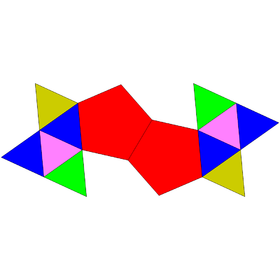In geometry, the metabidiminished icosahedron is one of the Johnson solids (J62).

Geometry is a branch of mathematics concerned with questions of shape, size, relative position of figures, and the properties of space. A mathematician who works in the field of geometry is called a geometer.

In geometry, a Johnson solid is a strictly convex polyhedron, which is not uniform, and each face of which is a regular polygon. There is no requirement that each face must be the same polygon, or that the same polygons join around each vertex. An example of a Johnson solid is the square-based pyramid with equilateral sides (J1); it has 1 square face and 4 triangular faces.
A Johnson solid is one of 92 strictly convex polyhedra that have regular faces but are not uniform (that is, they are not Platonic solids, Archimedean solids, prisms, or antiprisms). They were named by Norman Johnson, who first listed these polyhedra in 1966. [1]

In geometry, a polyhedron is a solid in three dimensions with flat polygonal faces, straight edges and sharp corners or vertices. The word polyhedron comes from the Classical Greek πολύεδρον, as poly- + -hedron.
A regular polyhedron is a polyhedron whose symmetry group acts transitively on its flags. A regular polyhedron is highly symmetrical, being all of edge-transitive, vertex-transitive and face-transitive. In classical contexts, many different equivalent definitions are used; a common one is that faces are congruent regular polygons which are assembled in the same way around each vertex.
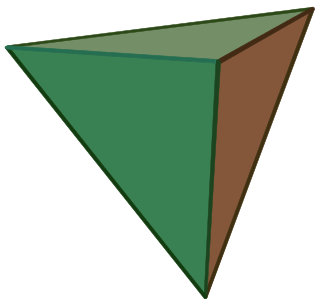
A uniform polyhedron is a polyhedron which has regular polygons as faces and is vertex-transitive. It follows that all vertices are congruent.
The name refers to one way of constructing it, by removing two pentagonal pyramids from a regular icosahedron, replacing two sets of five triangular faces of the icosahedron with two adjacent pentagonal faces. If two pentagonal pyramids are removed to form nonadjacent pentagonal faces, the result is instead the pentagonal antiprism.

In geometry, a pentagonal pyramid is a pyramid with a pentagonal base upon which are erected five triangular faces that meet at a point. Like any pyramid, it is self-dual.

In geometry, a regular icosahedron is a convex polyhedron with 20 faces, 30 edges and 12 vertices. It is one of the five Platonic solids, and the one with the most sides.

In geometry, the pentagonal antiprism is the third in an infinite set of antiprisms formed by an even-numbered sequence of triangle sides closed by two polygon caps. It consists of two pentagons joined to each other by a ring of 10 triangles for a total of 12 faces. Hence, it is a non-regular dodecahedron.
This page is based on this
Wikipedia article Text is available under the
CC BY-SA 4.0 license; additional terms may apply.
Images, videos and audio are available under their respective licenses.
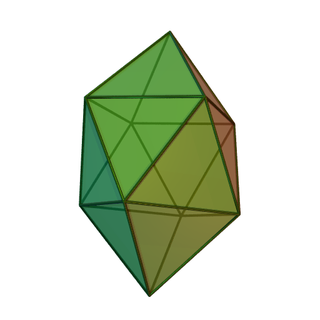
In geometry, the gyroelongated square bipyramid or heccaidecadeltahedron is one of the Johnson solids (J17). As the name suggests, it can be constructed by gyroelongating an octahedron by inserting a square antiprism between its congruent halves. It is one of the eight strictly-convex deltahedra.

In geometry, the gyroelongated square pyramid is one of the Johnson solids (J10). As its name suggests, it can be constructed by taking a square pyramid and "gyroelongating" it, which in this case involves joining a square antiprism to its base.
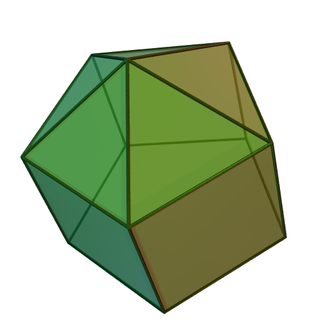
In geometry, the elongated pentagonal pyramid is one of the Johnson solids (J9). As the name suggests, it can be constructed by elongating a pentagonal pyramid (J2) by attaching a pentagonal prism to its base.
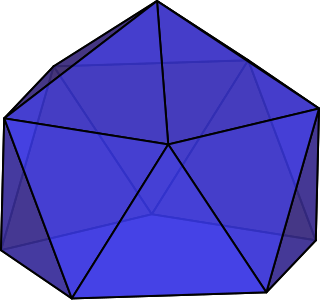
In geometry, the gyroelongated pentagonal pyramid is one of the Johnson solids (J11). As its name suggests, it is formed by taking a pentagonal pyramid and "gyroelongating" it, which in this case involves joining a pentagonal antiprism to its base.
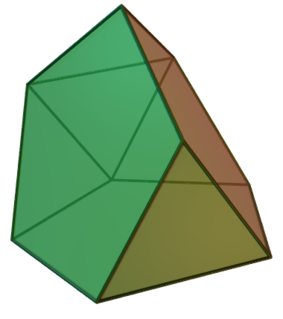
In geometry, the tridiminished icosahedron is one of the Johnson solids (J63).

In geometry, the gyroelongated pentagonal rotunda is one of the Johnson solids (J25). As the name suggests, it can be constructed by gyroelongating a pentagonal rotunda (J6) by attaching a decagonal antiprism to its base. It can also be seen as a gyroelongated pentagonal birotunda (J48) with one pentagonal rotunda removed.

In geometry, the augmented tridiminished icosahedron is one of the
Johnson solids (J64).

In geometry, the parabidiminished rhombicosidodecahedron is one of the
Johnson solids (J80).

In geometry, the tridiminished rhombicosidodecahedron is one of the Johnson solids (J83). It can be constructed as a rhombicosidodecahedron with three pentagonal cupolae removed.
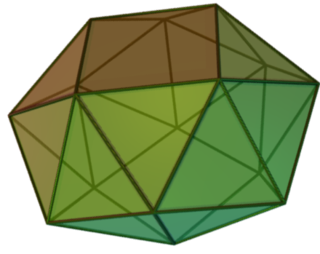
In geometry, the snub square antiprism is one of the Johnson solids (J85).
A Johnson solid is one of 92 strictly convex polyhedra that have regular faces but are not uniform. They were named by Norman Johnson, who first listed these polyhedra in 1966.

In geometry, the elongated pentagonal bipyramid is one of the Johnson solids (J16). As the name suggests, it can be constructed by elongating a pentagonal bipyramid (J13) by inserting a pentagonal prism between its congruent halves.
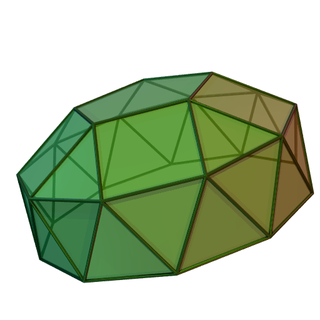
In geometry, the gyroelongated pentagonal cupola is one of the Johnson solids (J24). As the name suggests, it can be constructed by gyroelongating a pentagonal cupola (J5) by attaching a decagonal antiprism to its base. It can also be seen as a gyroelongated pentagonal bicupola (J46) with one pentagonal cupola removed.
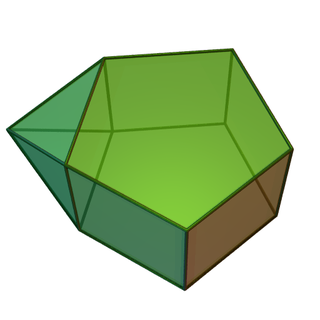
In geometry, the augmented pentagonal prism is one of the Johnson solids (J52). As the name suggests, it can be constructed by augmenting a pentagonal prism by attaching a square pyramid (J1) to one of its equatorial faces.

In geometry, the biaugmented pentagonal prism is one of the Johnson solids (J53). As the name suggests, it can be constructed by doubly augmenting a pentagonal prism by attaching square pyramids (J1) to two of its nonadjacent equatorial faces.

In geometry, the augmented dodecahedron is one of the Johnson solids (J58), consisting of a dodecahedron with a pentagonal pyramid (J2) attached to one of the faces. When two or three such pyramids are attached, the result may be a parabiaugmented dodecahedron, a metabiaugmented dodecahedron or a triaugmented dodecahedron.

In geometry, the parabiaugmented dodecahedron is one of the Johnson solids (J59). It can be seen as a dodecahedron with two pentagonal pyramids (J2) attached to opposite faces. When pyramids are attached to a dodecahedron in other ways, they may result in an augmented dodecahedron, a metabiaugmented dodecahedron, a triaugmented dodecahedron, or even a pentakis dodecahedron if the faces are made to be irregular.

In geometry, the metabiaugmented dodecahedron is one of the Johnson solids (J60). It can be viewed as a dodecahedron with two pentagonal pyramids (J2) attached to two faces that are separated by one face. When pyramids are attached to a dodecahedron in other ways, they may result in an augmented dodecahedron, a parabiaugmented dodecahedron, a triaugmented dodecahedron, or even a pentakis dodecahedron if the faces are made to be irregular.

In geometry, the triaugmented dodecahedron is one of the Johnson solids (J61). It can be seen as a dodecahedron with three pentagonal pyramids (J2) attached to nonadjacent faces.

